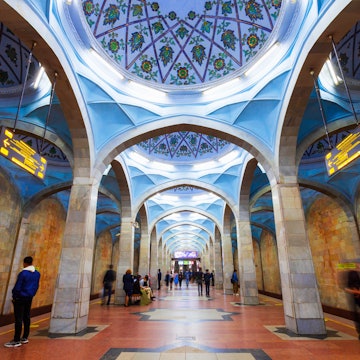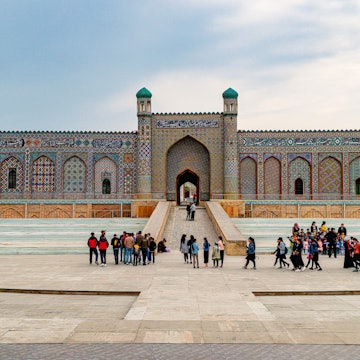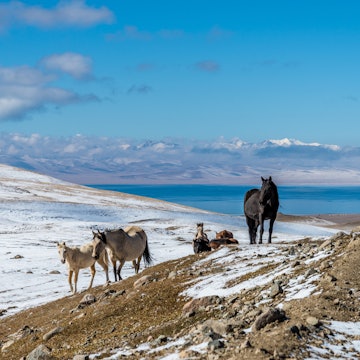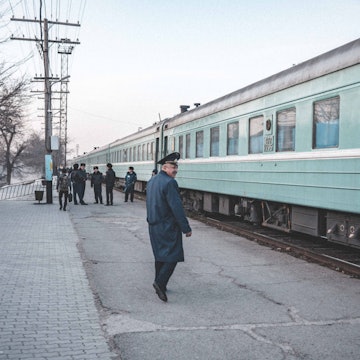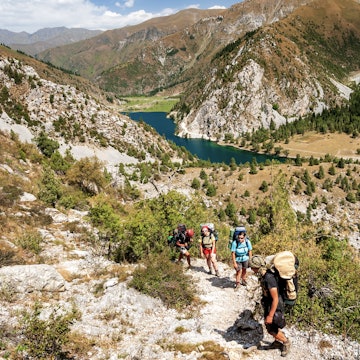

Pamir mountains, Tajikistan. Julia Mountain Photo/Shutterstock
Formally the Kyrgyz Republic, to everyone but the suits in parliament, this country is called Kyrgyzstan.
Descending towards Bishkek’s Manas airport, the snow-capped peaks of the Tien Shan run to the southern horizon. These mountains, dappled with alpine lakes and the high glaciers that feed them, are the setting beneath which Kyrgyz nomadic culture was born – and where those cultural traditions have seen a strong resurgence since the end of the Soviet period.
Visit for the absolute freedom of the outdoors – often it’s just you and the shepherds for a hundred kilometers – but also the opportunity for kayaking and paddle-boarding on Issyk-Köl, wildlife safaris searching for snow leopards or birdwatching trips during the migration season, and strolling through the ruins of Silk Routes cities and reconstructed caravansary alongside merchant trails that have been in use for over 1200 years.
Though Kyrgyzstan remains a somewhat niche travel destination – for now – it’s the kind of place that sees first-time visitors plotting their return before they’ve even left the country.

When should I go to Kyrgyzstan?
Summer is the best time to travel to Kyrgyzstan, with the country’s major horse trekking and hiking destinations widely accessible from late June through September. This is also the busiest period, though apart from the most popular handful of destinations, it’s rare to see tourist crowds. Visit one of the many Community-Based Tourism festivals held across the country in the summer months, dedicated to horse sports, Manas-epic storytelling, Salburun eagle hunting and more.
Winter is considerably less popular among travelers from afar (though Kazakhs and Uzbeks have long been in the know!), but for powder hounds and culture-loving travelers, late December into February is an excellent alternative to a summer visit. Ski resorts around Bishkek and Karakol are pleasant apart from the crowded New Year holiday period, and backcountry yurt lodges promise untouched powder and absolute solitude throughout the season. While the high-mountain yurt camps are closed, this is a great time to drop in at rural felt workshops or get a one-on-one demonstration of eagle hunting from the masters themselves.
How much time should I spend in Kyrgyzstan?
Any Kyrgyzstan travel itinerary will benefit from more time than you have available – driving on mountainous roads and long periods on foot or horseback means that slow travel is the default. With just a few nights, it’s possible to see the monuments, museums and Soviet-era architecture of Bishkek, and get out for a day in nature at nearby Ala-Archa National Park or Alamedin valley.
To make any multiday treks or horse trips, you’ll want at least a week, assuming you’ll wander only as far as Chuy or Issyk Köl regions and then right back to Bishkek, and even that’s cutting it tight. A trip that explores more of the country or gets to the remote edges of Kyrgyzstan would ideally last three to four weeks (or more), following only a loose itinerary and with plenty of potential for side trips down unmarked 4WD tracks or hiking trails.

How do I get to Kyrgyzstan?
Traveling to Bishkek's Manas airport in Kyrgyzstan from the US is possible with one-stop itineraries via Beijing (China Southern), Dubai (FlyDubai/Emirates) or Istanbul (Turkish). Getting to Kyrgyzstan from the UK or other European countries potentially adds Abu Dhabi (Wizz Air), Almaty (Air Astana), Antalya (Pegasus), Baku (Azerbaijan Air) and Tashkent (Uzbekistan Airways), among others.
Many visitors also enter overland on longer multicountry itineraries across Central Asia, though the partial closure of the Tajik border for several years leaves China, Kazakhstan or Uzbekistan as straightforward border crossings. Conventional wisdom for crossings near major cities like Osh and Bishkek is to head out in the morning as lines get progressively longer throughout the day.
Is it easy to get around in Kyrgyzstan?
Within the country, other than a handful of short flights between major cities, all travel is overland on a vast informal network of marshrutka minivans and shared taxis, or very occasionally buses. Locals largely use mobile messenger apps like Telegram to coordinate rides, but it’s still possible to show up to the bus station and haggle with drivers directly. In most cases, vehicles depart when full, and any timetables are little more than a general guideline.
Visitors looking to go into the mountains – including to the trailhead for popular Ala-Köl lake – will need to arrange private hire or be prepared to walk beyond settlements where the marshrutkas stop. Hitchhiking remains common in rural areas, with drivers typically expecting a small payment for gas. Remember, though, that hitching is never entirely safe, and travelers should understand that they are taking a small but potentially serious risk.

What are the top things to do in Kyrgyzstan?
Escape to Lake Son-Köl
On a short visit, a quick trip to Lake Son-Köl and back is the easiest way to experience Kyrgyzstan's great outdoors. The play of changing light against the lake and encircling mountains, the lack of cell signal and city noise, and the opportunity for a quick cold swim or a horseback trot along the shore give a good, quick introduction to some of the best aspects of travel in the country.
Live like a nomad with a yurtstay
Most travelers beeline to the nearest trailhead for multiday hikes or horseback treks, where they might find the unique combination of alpine landscapes and traditions of pastoralist hospitality that truly make the country special. Fall asleep at 3000m (9843ft) with a view of the Milky Way through a yurt’s roof, share a cup of fermented horse milk with your host before breakfast or ride alongside shepherds as they round up the herds to push a journey to something beyond a mere outdoors adventure.
Loop around the south of Kyrgyzstan
If your Kyrgyzstan travel itinerary is measured in weeks rather than days, consider the long, rugged loop through Naryn and Kazarman to the south of the country, stopping in the walnut forests of Arslanbob or "southern capital" Osh before trekking in the Alay Valley; returning to Bishkek via Sary Chelek lake and the Suusamyr valley.
Camp in Issyk-Köl and hike the Ala-Köl Pass
Add a couple more nights to make a loop around Lake Issyk-Köl, ideally staying at a tourist yurt camp or wild camping on a deserted beach, or head straight to Karakol to start the two- to three-day hike over the 3907m (12,818ft) Ala-Köl Pass for unsurpassed views of the eponymous lake and surrounding 5000m (16,404ft) peaks.
My favorite thing to do in Kyrgyzstan
For me, the most remarkable place in Kyrgyzstan is Sailmaluu Tash, a small mountain valley near Kazarman that’s only accessible for about a month each year. While the nature is beautiful, the real draw is apparent from the name: "Embroidered Stones." Spread across the valley are thousands of basalt slabs engraved with up to 10,000 petroglyphs, the earliest of which have been dated to the third millennium BCE. Scenes of hunting and farming, worship and war are visual short stories with every step, while the wider whole tells of thousands of years of pilgrimage to and veneration in this valley. Walking through the fields of stones is surreal, and it makes the shamanistic Tengrism tradition of ancient Kyrgyz tribes feel tangible in a way nowhere else in the country can match.
How much money do I need to travel in Kyrgyzstan?
Kyrgyzstan will feel like a good value for visitors traveling with strong currencies, with the Kyrgyz som ranging around 80–90 som to $1 in recent years. In many cases, transportation will be the biggest expense, whether that’s a private driver for a full tour or just point-to-point car hire for pickup and drop-off at trailheads not serviced by shared transport.
Expect these average daily costs:
Hostel bed: 150-800 som
Family guesthouse bed: 1000 som
Bed in a tourist yurt camp: 1000-1500 som
Hotel room for two: around 3200 som
Intra-city bus ride: 15-20 som
Bus Bishkek–Karakol: 580-600 som
Private car Bishkek–Karakol: from 8000 som
Samsa from a street stall: 85 som
Chuchuk horse sausage: 900 som
Restaurant dinner for two: 1000-1500 som
Espresso-based coffee: from 100-200 som
Beer/pint at the bar: 100-300 som
What should I pack for Kyrgyzstan?
Bring lots of layers, no matter the forecast. At high altitudes (including popular Son-Köl), the weather can swing through all four seasons in just a few hours. Especially if camping, pack for the possibility of rain and snow and something to keep you warm in the night.
What languages are spoken?
English is only common in the tourism industry or with well-educated city dwellers. Travelers with a baseline of Russian can get around fine, but if you’re starting from scratch, it’s worth focusing on simple Kyrgyz instead, as many locals will be delighted that you’ve made the effort. Here are a few key phrases to start you off:
Hello – salam
Goodbye – jakshy kalyngydzar
Thank you– rakhmat
Do you speak English? – siz angliyscha süylöy süzbü?
(In our pronunciation guides, ng is pronounced as in "sing", ö as the "u" in "fur" and ü as the "ew" in "few".)







